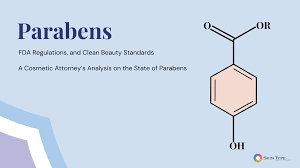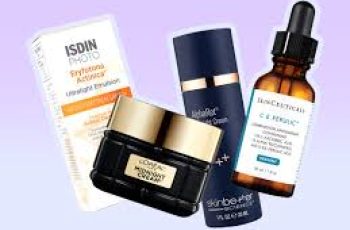
Parabens, FDA Regulation, and Clean Beauty Standards
Parabens are under regulatory scrutiny by the FDA and many groups are lobbying to remove parabens from skincare.(1) Why is this? I am a lawyer that specializes in cosmetic law and encouraging diversity in cosmetic ingredient research, and this is the state of paraben regulation in skincare around the world. In this blog I will discuss the laws and restrictions on using parabens in skincare around the world.
Parabens stand as the most widely employed preservatives in the cosmetic industry, serving a crucial role in enhancing the shelf life of various products. Their prevalence is attributed to their effective antimicrobial properties, which help inhibit the growth of bacteria, mold, and yeast in cosmetics and personal care items.(2)The parabens most frequently used in cosmetics include methylparaben, propylparaben, butylparaben, and ethylparaben.(3) These preservatives are found in various cosmetic products such as makeup, moisturizers, hair care items, and shaving products.
One of the key reasons for the widespread use of parabens is their versatility. They are compatible with a broad range of cosmetic formulations, providing stability and protection against microbial contamination. Parabens help prevent the deterioration of products, ensuring they remain safe and effective for consumers over an extended period.
Paraben Paradox: Beneficial or Dangerous?
FDA’s Stance on Parabens
While the FDA doesn’t have specific regulations solely for preservatives in cosmetics, it treats them similarly to other cosmetic ingredients under the Federal Food, Drug, and Cosmetic Act.(4) The agency continually reviews scientific studies on parabens’ safety and, as of now, has not found evidence indicating adverse effects on human health when used in cosmetics.
Regulation of Parabens in Skincare
The European Commission on Endocrine Disruption designates parabens as Category 1 priority substances.(5) The estimated daily human exposure to parabens is in the range of 76–142 mg.(6) This underscores the urgency for further investigations into resulting paraben levels in individuals.
Moreover, personal care products are a source of paraben exposure, evident in studies comparing(7) paraben levels among individuals who regularly use cosmetics and those who abstain.(7) Adolescent girls applying daily(9) makeup exhibit urinary propylparaben levels 20 times higher than infrequent or non-users.(8)The consistent use of body and face lotions, hair care items, sunscreens, and makeup consistently correlate with significantly elevated levels of urinary parabens, as indicated by multiple studies.
What Consumers Should Pay Attention to on Labels
Deciphering the ingredient list of your beloved serum poses a challenge for consumers seeking ingredient awareness. In this pursuit, it becomes pivotal to meticulously examine labels, with a specific focus on the commonly used parabens such as butylparaben, methylparaben, and propylparaben. Unraveling cosmetic labels, riddled with intricate terminology and various names for parabens, can be a complex task. Therefore, consumers are encouraged to familiarize themselves with alternative names for parabens, ensuring a comprehensive understanding and facilitating informed decision-making when selecting personal care products. In the journey towards ingredient awareness, consumers play an active role in promoting informed and health-conscious choices.
Environmental impact
Effect on Reefs: Parabens have been detected in various water bodies, including oceans and seas. Research has shown that these chemicals can be harmful to coral reefs.[9] Coral reefs are highly sensitive ecosystems, and exposure to parabens may contribute to coral bleaching, hinder the growth of corals, and disrupt the symbiotic relationships between corals and the microorganisms that support them.
Impact on Marine Life: Parabens can enter aquatic environments through wastewater discharge, and once in the water, they can bioaccumulate in aquatic organisms. Studies have found traces of parabens in various marine species, including fish and shellfish.[10] The accumulation of these chemicals in marine life raises concerns about the potential impact on the health and reproductive capabilities of these organisms.
Effects on Animals: Terrestrial animals may also be indirectly affected by parabens through the contamination of water sources. Additionally, there is evidence that parabens can interfere with the endocrine system in animals, affecting hormonal balance.[11] This disruption can lead to reproductive issues and other health problems in wildlife.
Water Supply Contamination: Parabens can enter water supplies through the discharge of treated wastewater. While conventional wastewater treatment processes can remove a portion of parabens, some may persist and end up in rivers, lakes, and groundwater. [12] This contamination of water supplies raises concerns about the potential long-term impact on human health as well, as people may be exposed to parabens through drinking water and the consumption of fish and other aquatic products.
Legal Challenges in the Cosmetics Industry: The Paraben Predicament
In recent years, the cosmetics industry has found itself entangled in legal battles, with consumers increasingly demanding transparency and accountability for the products they use. One notable case shedding light on these issues is the class-action lawsuit filed by Lindsey Finster against Sephora USA, challenging the credibility of the “clean at Sephora” program. [13]
The heart of the dispute lies in the alleged misleading nature of the label, with Finster asserting that products may not genuinely be free from harmful substances like parabens, sulfates, and phthalates, despite the promise of cleanliness. This case sheds light on the broader issue of greenwashing in cosmetics, where products are marketed as environmentally friendly or devoid of harmful ingredients without meeting these criteria. It underscores the urgent need for clearer regulations and heightened consumer awareness regarding product labeling, particularly concerning the presence of parabens. As consumers become more discerning and the legal landscape evolves, such lawsuits may drive the cosmetics industry toward greater accountability and environmental consciousness.
Stricter Guidelines, Innovative Alternatives, and Advocacy by Marcha Isabelle Chaudry
In the dynamic realm of paraben regulation, I’ve stood as a prominent advocate[14] for ingredient safety in cosmetics. Lobbying on this critical issue in Washington DC, I’ve not only amplified the dialogue surrounding the impact of cosmetic ingredients on vulnerable populations, but I’ve also testified before both the FDA and the U.S. Congress, offering invaluable perspectives on the matter.[15]
My proactive engagement reflects a growing consciousness about the necessity for transparent and equitable regulations in the cosmetics industry. As we peer into the future of paraben regulation, my advocacy efforts serve as a driving force, shaping policies that prioritize consumer health and environmental sustainability. This convergence of advocacy and regulation signals a promising era where well-informed decisions, industry innovation, and public well-being converge to redefine the landscape of cosmetic safety.
vulnerable populations
Vulnerable Populations Impacted by Parabens
Within the realm of personal care products, the discussion on parabens extends beyond cosmetic considerations to spotlight specific vulnerable populations. From pregnant individuals and children to the elderly and economically disadvantaged, the potential risks of paraben exposure vary across diverse demographics. It’s important to note that these categories are interconnected, and individuals may fall into multiple at-risk segments simultaneously. Comprehensive risk assessments should consider these factors to develop targeted strategies for mitigating potential harm.
Other Names for Parabens
Within the intricate world of cosmetic formulations, parabens assume various disguises under standardized nomenclature known as International Nomenclature of Cosmetic Ingredients (INCI) names. These include Methylparaben, Ethylparaben, Propylparaben, Butylparaben, Isobutylparaben, Isopropylparaben, Benzylparaben, Sodium Methylparaben, Sodium Ethylparaben, and Sodium Propylparaben.[16] Dissecting the INCI names reveals the pervasive presence of these synthetic preservatives in personal care products. From the ubiquity of Methylparaben to the sodium salt forms utilized for their water solubility, recognizing these INCI names is crucial for consumers navigating product labels and seeking to make informed choices about the presence of parabens in their cosmetic selections.
Paraben structure
The Future of Paraben Regulation
As concerns over paraben impacts rise, the regulatory landscape is poised for change. Recent lawsuits, such as the one against Sephora USA, underscore a growing demand for transparent labeling. Anticipated shifts include more stringent guidelines from regulatory bodies like the FDA and EMA, potentially limiting allowable paraben concentrations. The push for “clean” beauty products is also driving the industry towards exploring innovative, safe alternatives to parabens. In essence, the future of paraben regulation is steering towards a balance between safeguarding health, encouraging innovation, and addressing environmental considerations.


